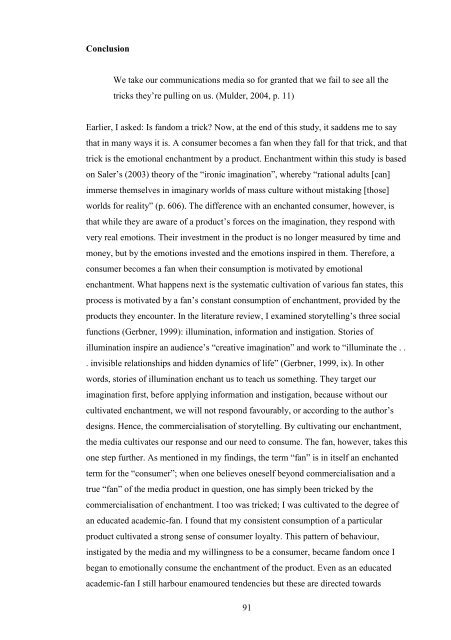The Case Study of Sherlock Holmes (2009) - Scholarly Commons ...
The Case Study of Sherlock Holmes (2009) - Scholarly Commons ...
The Case Study of Sherlock Holmes (2009) - Scholarly Commons ...
You also want an ePaper? Increase the reach of your titles
YUMPU automatically turns print PDFs into web optimized ePapers that Google loves.
Conclusion<br />
We take our communications media so for granted that we fail to see all the<br />
tricks they‟re pulling on us. (Mulder, 2004, p. 11)<br />
Earlier, I asked: Is fandom a trick? Now, at the end <strong>of</strong> this study, it saddens me to say<br />
that in many ways it is. A consumer becomes a fan when they fall for that trick, and that<br />
trick is the emotional enchantment by a product. Enchantment within this study is based<br />
on Saler‟s (2003) theory <strong>of</strong> the “ironic imagination”, whereby “rational adults [can]<br />
immerse themselves in imaginary worlds <strong>of</strong> mass culture without mistaking [those]<br />
worlds for reality” (p. 606). <strong>The</strong> difference with an enchanted consumer, however, is<br />
that while they are aware <strong>of</strong> a product‟s forces on the imagination, they respond with<br />
very real emotions. <strong>The</strong>ir investment in the product is no longer measured by time and<br />
money, but by the emotions invested and the emotions inspired in them. <strong>The</strong>refore, a<br />
consumer becomes a fan when their consumption is motivated by emotional<br />
enchantment. What happens next is the systematic cultivation <strong>of</strong> various fan states, this<br />
process is motivated by a fan‟s constant consumption <strong>of</strong> enchantment, provided by the<br />
products they encounter. In the literature review, I examined storytelling‟s three social<br />
functions (Gerbner, 1999): illumination, information and instigation. Stories <strong>of</strong><br />
illumination inspire an audience‟s “creative imagination” and work to “illuminate the . .<br />
. invisible relationships and hidden dynamics <strong>of</strong> life” (Gerbner, 1999, ix). In other<br />
words, stories <strong>of</strong> illumination enchant us to teach us something. <strong>The</strong>y target our<br />
imagination first, before applying information and instigation, because without our<br />
cultivated enchantment, we will not respond favourably, or according to the author‟s<br />
designs. Hence, the commercialisation <strong>of</strong> storytelling. By cultivating our enchantment,<br />
the media cultivates our response and our need to consume. <strong>The</strong> fan, however, takes this<br />
one step further. As mentioned in my findings, the term “fan” is in itself an enchanted<br />
term for the “consumer”; when one believes oneself beyond commercialisation and a<br />
true “fan” <strong>of</strong> the media product in question, one has simply been tricked by the<br />
commercialisation <strong>of</strong> enchantment. I too was tricked; I was cultivated to the degree <strong>of</strong><br />
an educated academic-fan. I found that my consistent consumption <strong>of</strong> a particular<br />
product cultivated a strong sense <strong>of</strong> consumer loyalty. This pattern <strong>of</strong> behaviour,<br />
instigated by the media and my willingness to be a consumer, became fandom once I<br />
began to emotionally consume the enchantment <strong>of</strong> the product. Even as an educated<br />
academic-fan I still harbour enamoured tendencies but these are directed towards<br />
91

















